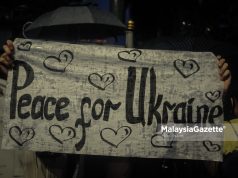The following article is sent to the editorial of MalaysiaGazette by reader, Hafiz Hassan.
When a missile is fired in an armed conflict – even in self-defence – it must target the opposing combatants or a military target. It cannot be fired to target civilians and civilian objects, like the building housing Al Jazeera and AP news agency which was flattened to ground zero by Israeli missiles. Or the Palestinian enclave that was the target of Israeli strikes which killed Palestinian civilians in the Gaza Strip on Sunday, resulting in the worst daily toll in almost a week of deadly clashes.
It is one of the central rules of armed conflict which regulates the conduct of hostilities that civilian casualties are permitted only when they are incidental to an attack on a legitimate military target. The rule is called the collateral damage rule, also known as the proportionality rule. It is meant to offer protection to civilians in wartime (Valerie Epps, 2013). Ten years earlier, Judith Gardam (1993) explained the rule as a fundamental component of the law on the use of force and the law of armed conflict. It is “a balance to be struck between the achievement of a military goal and the cost in terms of lives.” According to Gardam, “in the law of armed conflict, the notion of proportionality is based on the fundamental principle that belligerents do not enjoy an unlimited choice of means to inflict damage on the enemy.”
The fundamental principle is otherwise put as one that distinguishes military personnel (combatants) and military objects, on the one hand, and civilians and civilian objects, on the other hand. Epps explains as follow:
“Civilians and civilian objects may not be attacked. Combatants and military objects can be attacked. When a combatant kills or injures an opposing combatant or destroys a military object it is not a crime under the laws of armed combat. Although civilians or civilian objects may end up being killed, injured, or destroyed in warfare, such casualties are only tolerated when the civilian destruction is incidental to an attack on a legitimate military target, and then only when the civilian casualties are not considered likely to be excessive in relation to the concrete and direct military advantage anticipated.”
In simpler words, an attack must be directed against a military object and only with means which are not excessive in relation to the military objective.
Cries of war crimes and crimes against humanity are valid. U.N. Secretary-General Antonio Guterres cannot just be “dismayed” by civilian casualties in Gaza and “deeply disturbed” by Israel’s strike on a building containing international media outlets.
He must say it loud: that war crimes and crimes against humanity are being committed in Gaza.

















